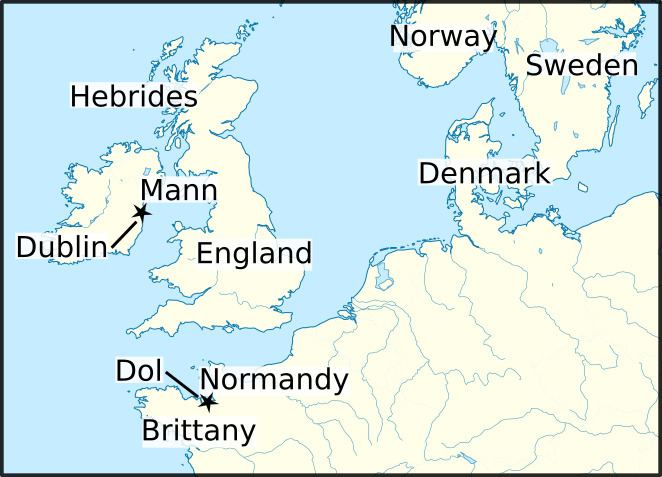 | ||
Lagmann mac Gofraid may have been an early eleventh-century ruler of the Kingdom of the Isles. He seems to have been a son of Gofraid mac Arailt, King of the Isles, and was likely a member of the Uí Ímair kindred. According to an eleventh-century source, Lagmann was closely associated with Óláfr Haraldsson, a future King of Norway. According to an eleventh-century source, both men are recorded to have lent assistance to Knútr, son of Sveinn Haraldsson, King of Denmark, although it is possible that this account actually refers to Óláfr's campaigning in England several years beforehand. Lagmann and Óláfr are also recorded to have assisted Richard II, Duke of Normandy. The two are specified to have not only ravaged lands in Brittany on behalf of Richard, but were tasked to counter Richard's opponent Odo II, Count of Chartres. Lagmann's activities on the Continent may have arisen as a result of being forced from the Isles following the death of his possible brother Ragnall mac Gofraid, King of the Isles in 1004 or 1005. Lagmann's son, Amlaíb, is recorded to have perished at the Battle of Clontarf in 1014. If Lagmann died at about this time as well, it could account for the record of Hákon Eiríksson assuming control of the Isles.
King of the Isles
According to the eleventh-century Gesta Normannorum Ducum, Knútr (died 1035), son of Sveinn Haraldsson, King of Denmark (died 1014) sought military assistance from a king of the Noricorum named Óláfr, and a king of Suauorum named Lacman. Whilst Óláfr seems to be identical to Óláfr Haraldsson (died 1030), there is otherwise no known Swedish king named Lagmann. In fact, Gesta Normannorum Ducum appears refer to a King of the Isles rather than a King of Sweden, with Suauorum likely being a form of Sudrorum. In Scandinavian sources, the Hebrides and Mann—the islands that made up the Kingdom of the Isles—were known as the Suðreyjar, an Old Norse term meaning "Southern Islands".
The Gaelic personal name Lagmann is derived from the Old Norse lǫgmaðr ("lawman"). The latter word originally referred to a profession, and was later adopted as a personal name. Although the name itself is historically found in the Isles as early the tenth century, it is not attested in Scandinavia proper. Corroboration that there was indeed a contemporaneous potentate from the Isles who bore the name is preserved by the fifteenth–sixteenth-century Annals of Ulster and the twelfth-century Cogad Gáedel re Gallaib. These sources reveal that a prominent Islesmen named Amlaíb, described as the son of Lagmann mac Gofraid, fought and died at the Battle of Clontarf in 1014. The patronym accorded to Lagmann in these sources suggests that his father was Gofraid mac Arailt, King of the Isles (died 989), and thus a brother of Ragnall mac Gofraid, King of the Isles (died 1004/1005). It is conceivable that Lagmann's son led the Hebridean contingent at Clontarf.
According to the twelfth-century Roman de Rou, and Gesta Normannorum Ducum, after Lagmann and Óláfr assisted Knútr, the two were approached by Richard II, Duke of Normandy, who needed aid battling against Odo II, Count of Chartres. Lagmann and Óláfr are also stated to have campaigned on behalf of the Normans against the Bretons in Brittany where the two sacked Dol. It is possible that a record of this ravaging of Dol—and the unidentified coastal site of Hringsfjǫrðr—is preserved by Víkingarvísur, a piece of contemporary praise poetry composed by Sigvatr Þórðarson, extolling battles fought by Óláfr in England, Scandinavia, and on the Continent. In any event, when Robert II, King of the Franks (died 1031) afterwards intervened between the duke and count, Gesta Normannorum Ducum records that Lagmann and Óláfr were presented with gifts from the king, and persuaded to return home to their own countries.
The exact chronology of the events attributed to Lagmann on the Continent is uncertain. There is reason to suspect that the episode concerning 1014 may be erroneous, and actually refers to Óláfr's otherwise known campaigning with Þorkell inn hávi (fl. 1009–1023) in 1009–1011. Certainly, no English source associates Óláfr with Knútr in 1014, at about the time when the former was active in Scandianvia claiming the Norwegian kingship. Although it is likewise uncertain who ruled the Isles at about the time of the Battle of Clontarf, it is conceivable that Lagmann held a degree of authority on Mann. One possibility is that the record of his actions in England and on the Continent reveal that he had then been exiled from the Isles. Such an expatriation could have come about in the immediate aftermath of the death of his aforesaid brother in 1005. If correct, Brian Bóruma mac Cennétig, High King of Ireland (died 1014) could have seized upon Ragnall's demise and forced Lagmann from the Isles in an attempt to wrest control of realm for himself.
If Lagmann and his son died at about the same time, the lack of a suitable native candidate to succeed as King of the Isles may account for the record of the region falling under the control of the Norwegian Hákon Eiríksson (died 1029/1030). Evidence that Knútr installed Hákon as overlord of the Isles may be preserved by the twelfth-century Ágrip af Nóregskonungasǫgum. The historicity of this event is uncertain, however, and Hákon's authority in the Isles is not attested by any other source. If Hákon had indeed possessed overlordship of the Isles, his eventual demise in 1029 or 1030 may well have paved the way for the rise of Echmarcach mac Ragnaill, King of Dublin and the Isles (died 1064/1065), a man who may have been a son of Lagmann's brother, and who first appears on record in about 1031.
